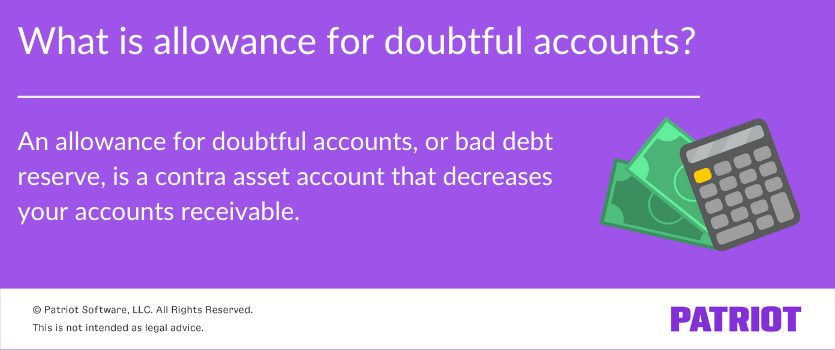When it comes to your small business, you don’t want to be in the dark. Your accounting books should reflect how much money you have at your business. If you use double-entry accounting, you also record the amount of money customers owe you. But, what happens if they don’t pay? To protect your business, you can create an allowance for doubtful accounts.
What is allowance for doubtful accounts?
An allowance for doubtful accounts, or bad debt reserve, is a contra asset account (either has a credit balance or balance of zero) that decreases your accounts receivable. When you create an allowance for doubtful accounts entry, you are estimating that some customers won’t pay you the money they owe.
When customers don’t pay you, your bad debts expenses account increases. A bad debt is debt that you have officially written off as uncollectible. Basically, your bad debt is the money you thought you would receive but didn’t.
In addition to bad debt, there’s such a thing as doubtful debt. Unlike bad debt, doubtful debt isn’t officially uncollectible debt. Doubtful debt is money you predict will turn into bad debt, but there’s still a chance you will receive the money.
Use an allowance for doubtful accounts entry when you extend credit to customers. Although you don’t physically have the cash when a customer purchases goods on credit, you need to record the transaction.
Use the accrual accounting method if you extend credit to customers. If a customer purchases from you but does not pay right away, you must increase your Accounts Receivable account to show the money that is owed to your business.
If a customer never pays you, the unpaid payments become bad debts. And, having a lot of bad debts drives down the amount of revenue your business should have. ADA accounting helps increase the accuracy of your books. By predicting the amount of accounts receivables customers won’t pay, you can anticipate your losses from bad debts.
A reserve for doubtful debts can not only help offset the loss you incur from bad debts, but it also can give you valuable insight over time. For example, your ADA could show you how effectively your company is managing credit it extends to customers. It can also show you where you may need to make necessary adjustments (e.g., change who you extend credit to).

Allowance for doubtful accounts on the balance sheet
When you create an allowance for doubtful accounts, you must record the amount on your business balance sheet.
Because an allowance for doubtful accounts is a contra asset that reduces your accounts receivables, you record it under assets. It may look something like this:
- Assets
- Cash: 500
- Accounts receivable: 2,000
- Less allowance for doubtful accounts: (200)
If the doubtful debt turns into a bad debt, record it as an expense on your income statement.
Allowance for doubtful accounts calculation
For many business owners, it can be difficult to estimate your bad debt reserve. There are a few different ways you can calculate your predictions.
Historical data
You can make your predictions based on historical data. Use the percentage of bad debts you had in the previous accounting period to help determine your bad debt reserve.
For example, if 3% of your sales were uncollectible, set aside 3% of your sales in your ADA account. Say you have a total of $70,000 in accounts receivable, your allowance for doubtful accounts would be $2,100 ($70,000 X 3%).
Aging of accounts receivable
Another way you can calculate ADA is by using the aging of accounts receivable method. With this method, you can group your outstanding accounts receivable by age (e.g., under 30 days old) and assign a percentage on how much will be collected.
For example, say 10% of accounts receivable that are between 31 – 60 days are uncollectible, and you are waiting on $3,000 worth of payments in this period (0.10 X $3,000 = $300). Additionally, 5% of accounts receivable under 30 days are uncollectible, and you are waiting on $5,000 for this aging period (0.05% X $5,000 = $250).
Your allowance for doubtful accounts estimation for the two aging periods would be $550 ($300 + $250).
Allowance for doubtful accounts journal entry
When it comes to bad debt and ADA, there are a few scenarios you may need to record in your books.
To predict your company’s bad debts, create an allowance for doubtful accounts entry. To balance your books, you also need to use a bad debts expense entry. To do this, increase your bad debts expense by debiting your Bad Debts Expense account. Then, decrease your ADA account by crediting your Allowance for Doubtful Accounts account.
| Date | Account | Notes | Debit | Credit |
| XX/XX/XXXX | Bad Debts Expense | Estimated default payments | X | |
| Allowance for Doubtful Accounts | X |
Bad debt reserve journal entry example
As you can tell, there are a few moving parts when it comes to allowance for doubtful accounts journal entries. To make things easier to understand, let’s go over an example of bad debt reserve entry.
Let’s say your business brought in $60,000 worth of sales during the accounting period. Based on historical trends, you predict that 2% of your sales from the period will be bad debts ($60,000 X 0.02). Debit your Bad Debts Expense account $1,200 and credit your Allowance for Doubtful Accounts $1,200 for the estimated default payments.
| Date | Account | Notes | Debit | Credit |
| XX/XX/XXXX | Bad Debts Expense | Estimated default payments | 1,200 | |
| Allowance for Doubtful Accounts | 1,200 |
If a doubtful debt turns into a bad debt, credit your Accounts Receivable account, decreasing the amount of money owed to your business. You must also debit your Allowance for Doubtful Accounts account.
If you can’t collect the money owed to your business, your journal entry should look like this:
| Date | Account | Notes | Debit | Credit |
| XX/XX/XXXX | Allowance for Doubtful Accounts | Default payments | X | |
| Accounts Receivable | X |
Customer pays example
In some cases, you may write off the money a customer owed you in your books only for them to come back and pay you. If a customer ends up paying (e.g., a collection agency collects their payment) and you have already written off the money they owed, you need to reverse the account.
To reverse the account, debit your Accounts Receivable account and credit your Allowance for Doubtful Accounts for the amount paid.
| Date | Account | Notes | Debit | Credit |
| XX/XX/XXXX | Accounts Receivable | Default payments | X | |
| Allowance for Doubtful Accounts | X |
With Patriot’s online accounting software, you can track unpaid invoices and easily update your accounting books. Plus, we offer free, USA-based support. Get your free trial today!
This article has been updated from its original publication date of November 12, 2014.
This is not intended as legal advice; for more information, please click here.
